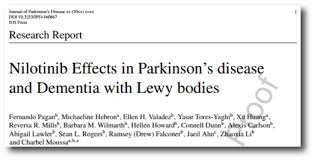Groundbreaking Discovery in Treatment of Parkinson’s Disease

In the Age of Information, neuroscientific discovery has become a field that will unlock a world of opportunity for society’s understanding of not only the biological processes that characterize the way we move, interact, think and live, but also how we treat ailments that affect neurological functions. The beauty of the brain lies in its complexity, the true marker of what makes us individuals. The broad field of neuroscience focuses on the brain and its impact on behavior and cognitive functions, and examining the way the nervous system reacts to a variety of disorders.
Parkinson’s disease is a progressive nervous system disorder that affects movement. It can lead to difficulty walking, problems with balance and coordination and bradykinesia. Parkinsons primarily has an effect on the neurons in the substantia nigra, a part of the basal ganglia. Dopamine, a neurotransmitter that is crucial to the body’s coordination and movement, lacks in patients with Parkinson’s disease. As the disease progresses, the amount of dopamine produced in the brain decreases, thus leaving a person unable to control movement. This disorder of the basal ganglia is classified as hypokinetic, also known as lack of movement in both the indirect and direct pathways. Currently there is no real cure for Parkinsons, only remedies to manage its symptoms.
The common treatments available include medication and surgery to manage its symptoms. Some examples of this include L-Dopa which is an amino acid that naturally exists in humans. Vital to its role as a treatment for Parkinsons, L-DOPA works by crossing the blood brain barrier. In doing so, the dopamine concentration in the brain is increased. Deep Brain Stimulation, or DBS, is another treatment used to reduce the tremors, slowness or stiffness that are all characteristic of people with Parkinsons. As previously mentioned, however, Parkinsons is such a debilitating and painful neurological disorder that scientists are striving to find answers for the most effective way to eradicate the disease.
This desire to find a cure leads to the experimentation of the impact nilotinib hydrochloride could have on people with Parkinsons. Nilotinib is a tyrosine kinase Abelson inhibitor, an enzyme that has the ability to activate proteins by signal transduction cascades. According to the National Cancer Institute, the medical definition of a tyrosine kinase inhibitor is “a substance that blocks the action of enzymes called tyrosine kinases.” Tyrosine kinases are crucial to a variety of cell functions which include cell signalling, and regulation of mitosis. But, in patients with Cancer, Dementia, or Parkinsons, these enzymes may be over activated resulting in metastasis or further depletion of essential neurotransmitters. A signal transduction cascade is defined as the network of enzymes that work together to amplify the incoming signal of a cell to elicit a specific and accurate physiological response by the cell. In Parkinsons, the neurons connecting the substantia nigra to the striatum die. Nilotinib is speculated to reverse that loss and improve motor behavior by targeting the Abl tyrosine kinase.
One such study that investigated this assertion examined the safety and pharmacokinetics of Nilotnib for treating Parkinsons. The article was entitled: “Cancer Drug Shows Promise for Parkinson’s Disease” and Nilotinib was presented as a drug used to fight chronic leukemia, but one that shows potential for treating the symptoms of Parkinson’s disease. The article goes on to explain that the Nilotinib works by increasing the production of dopamine and halting the decline of motor function. Regarding the state of patients in the clinical trial, the article suggests that Nilotinib was well tolerated by most patients and lowered the level of toxic proteins that lead to the death of dopamine neurons. The article also points out that the results of the trial revealed administering Nilotinib to the patients reduced the presence of alpha synuclein and tau – biomarkers of Parkinsons- by 20% and 30% respectively.
Additionally, the dopamine metabolites were said to increase by more than 50% , as well as reports of better motor function and quality of life by patients. It is evident that the media report of this clinical trial was released as a tool to inform the public, while advertising a possible drug that can remedy such a horrible, well known disorder. Of course, not all the information presented in the article is consistent with other findings on the same topic. Another recent trial of Nilotinib use for Parkinson’s disease found no clinical meaningful benefit for patients. The article states: “The implication is that the justification for a phase 3 trial is tenuous at best, and with the recent announcement of the negative competing trial NILO-PD, to be discouraged”.
The journal also expanded on the 12% of patients that were unable to complete the trial due to serious and non serious adverse effects. These included falls and hip fractures, urinary tract infections, skin diseases, orthostatic hypertension and pneumonia. These circumstances, however, were unrelated to administration of Nilotinib.
Something the journal mentioned was the possibility of a phase three trial that would evaluate and identify specific dopamine metabolites, including HVA and DOAPC. There is also potential for investigating how to deregulate the aggregation of alpha synuclein in the brain using this drug. Neuroscientists continue to search for answers to questions like these in all aspects of the field. With all the advancement that continues to persist as curiosity inspires generations of future neuroscientists, the sky’s the limit!

